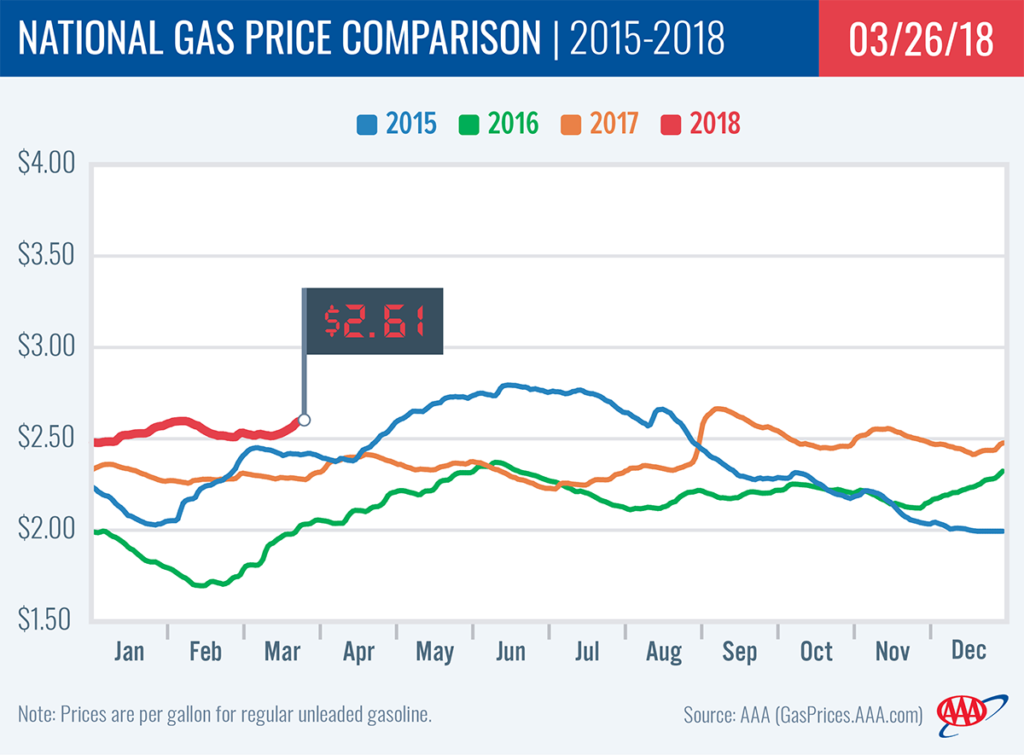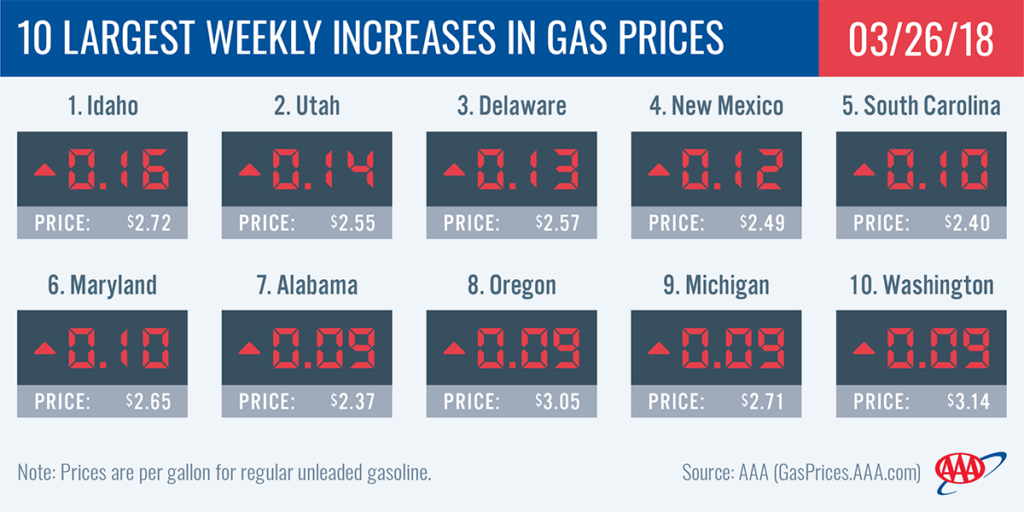With the arrival for spring, gas prices immediately became more expensive nationwide. The national gas price average is $2.61, which is a nickel more expensive on the week. Six states are seeing double-digit increases: Idaho (+16 cents), Utah (+14 cents), Delaware (+13 cents), New Mexico (+12 cents), South Carolina (+10 cents) and Maryland (+10 cents). As prices soar, the Energy Information Administration (EIA) reports that demand dropped to 9.3 million b/d as gasoline stocks dipped (1.7 million b/d) on the week.
“Right now we are seeing the market starting to purge winter-blend gasoline to make room for summer-blend,” said Jeanette Casselano, AAA spokesperson. “The jump in gas prices is just the beginning for the season. AAA forecasts the national gas price average will be as much as $2.70/gallon this spring and summer.”
Today’s national gas price average ($2.61) is nine cents more than a month ago and 33 cents more expensive than this time last year.
Quick Stats
- The nation’s top 10 largest weekly increases are: Idaho (+16 cents), Utah (+14 cents), Delaware (+13 cents), New Mexico (+12 cents), South Carolina (+10 cents), Maryland (+10 cents), Alabama (+9 cents), Oregon (+9 cents), Michigan (+9 cents) and Washington (+9 cents).
- The nation’s top 10 least expensive markets are: Missouri ($2.31), Mississippi ($2.35), Arkansas ($2.36), Alabama ($2.37), Louisiana ($2.39), Texas ($2.39), South Carolina ($2.40), Oklahoma ($2.40), Tennessee ($2.41) and Ohio ($2.42).
West Coast
Pump prices in West Coast states are among the highest in the nation: Hawaii ($3.51), California ($3.47), Alaska ($3.09), Washington ($3.14), Oregon ($3.05) and Nevada ($2.93). On the week, all drivers in these states saw an increase in prices at the pump. Washington (+9 cents) and Oregon (+9 cents) saw the largest jumps, while Nevada (+7 cents) and California (+6 cents) were close behind. Alaska (+2 cents) and Hawaii (+1 cent) saw the smallest increases.
According to the EIA’s latest weekly report, total gasoline stocks in the region increased last week by 400,000 bbl. They now sit at 32.8 million bbl, which is approximately 4.2 million bbl more than last year’s level at this time.
Great Lakes and Central
Gas prices rose sharply in the Great Lakes and Central region on the week. Michigan (+9 cents) and Nebraska (+9 cents) saw the largest increase followed by Indiana (+8 cents), Iowa (+7 cents) and Illinois (+7 cents).
Within the region and the country, Ohio is the outlier seeing gas prices drop one cent since last Monday.
North Dakota ($2.57) was the only state to see prices remain stable in the region in the last week, but continues to be among the most expensive among the Great Lakes and Central. Coincidentally, the state is one of only two in the region to see a gas price drop on the compared to last month: North Dakota (-3 cents) and Minnesota (-2 cents). All other states are paying more to fill up compared to February 2018 with three states paying a considerable amount more on the month: Michigan (+22 cents), Indiana (+21 cents) and Illinois (+15 cents).
For a second week, gasoline inventories dropped. According to EIA data, the region took a 1.3 million bbl draw to register at 58.8 million bbl. Overall, inventory levels stand just below this time last year, but about 3.5 million bbl above the five-year average for this time of year.
South and Southeast
Three states from the South and Southeast region land on the top 10 list with the biggest change with two of them seeing at least an increase of a dime: New Mexico (+12 cents), South Carolina (+10 cents) and Alabama (+9 cents). Texas (+8 cents) and Mississippi (+7 cents) also saw large jumps on the week. Gas prices range from as cheap as $2.35 in Mississippi to as expensive as $2.55 in Florida.
Compared to March 2017, motorists in South Carolina are seeing the biggest difference in gas prices of all states in the region at 38 cents more a gallon. Prior to Hurricane Harvey, the state typically ranked as the cheapest gas prices in the country week after week. While it has occasionally re-taken the cheapest spot since the hurricane prices in the state have fluctuated.
With a 1 million bbl decrease, gasoline inventories fall below the 84 million mark. However, total inventories are at a 4 million bbl surplus compared to last March, according to the EIA.
Mid-Atlantic and Northeast
In the Mid-Atlantic and Northeast region, all states are paying more on the week with motorists in Delaware (+13 cents) and Maryland (+10 cents) seeing double-digit increases at the pump. Washington, D.C. ($2.80), Pennsylvania ($2.80) and New York ($2.73) tout the most expensive prices in the region and could trend closer to the $3/gallon mark this spring.
Paying nearly 40-cents more, four states in the region land on the top 10 list with the biggest changes year-over-year: Tennessee (+37 cents), Delaware (+37 cents), Vermont (+36 cents) and Maryland (+36 cents).
Gasoline inventories increased by a small 206,000 bbl on the week, but still sit at 59.7 million bbl. This is the first year since 2014 that March inventories sit below 60 million bbl. Year-over-year, inventories are at an 8.5 million bbl deficit in the region, according to EIA data.
Rockies
With a 16-cent increase, Idaho saw the biggest spike in gas prices in the region and in the country on the week. The state also ranks as the 10th most expensive state to fill up in nationwide. The spike brings Idaho’s gas price average ($2.72) to the most expensive in the region. Utah (+14 cents) saw the second largest spike in the country and in the region on the week. Motorists in Colorado (+5 cents) and Wyoming (+3 cents) are paying more on the week while Montana’s ($2.58) average saw no change.
With a 77,000 bbl add, gasoline inventories continue to register above 8 million bbl. Inventory totals for the region are about 278,000 bbl ahead of this time last year, according to the EIA.
Oil market dynamics
At the close of Friday’s formal trading session on the NYMEX, WTI increased $1.58 to settle at $65.88. The futures market for crude oil rallied last week after EIA’s report revealed crude inventories fell for the third consecutive week. Crude oil inventories dropped 2.6 million barrels from the previous week, and storage levels across the country now total 428.3 million barrels. When compared to last March, current domestic crude inventories are 104.8 million barrels lower. This year-over-year change could be attributed to higher than usual gasoline demand in the U.S. for this time of the year, which has also coincided with growing crude and gasoline exports from the U.S.
The lowering crude data also signaled that OPEC’s production reduction agreement with other large producers, including Russia, is helping to drain global crude supplies and lift the price per barrel. The reduction agreement will be in effect through the end of 2018, and it may extend into 2019. Last week in an interview, Saudi Arabia’s Energy Minister Khalid al-Falih said that OPEC would need to continue coordinating with non-OPEC countries in the agreement on what measures to take to curb global crude supplies in 2019. This news contributed to the WTI rally that occurred at the end of last week. The supply reduction agreement, which has been in place since January 2017, has helped participating countries remove 1.8 million b/d from global crude supplies. While the agreement has been in place there has been a reduction in the global supply in crude — which has also helped to lift the price. An extension of the current agreement will likely push prices up and supplies down further.
Meanwhile, U.S. crude production continues to boom. According to EIA’s data last week, production in the U.S. hit another record high of 10.41 million b/d. As another sign of expanded crude production growth in the U.S., Baker Hughes reported that the U.S. gained four active oil rigs last week, bringing the total to 804. The total is 152 more rigs than last year at this time.
Motorists can find current gas prices along their route with the free AAA Mobile app for iPhone, iPad and Android. The app can also be used to map a route, find discounts, book a hotel and access AAA roadside assistance. Learn more at AAA.com/mobile.



